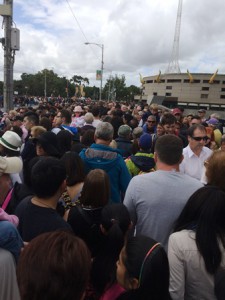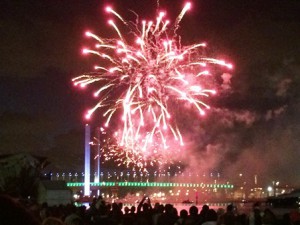
Submitted by Timothy D’Agostino on the 2015 winter session program in Australia sponsored by the College of Engineering…
This Monday, I had the opportunity to experience Australia Day. Officially, the holiday commemorates the arrival of the British First Fleet in present day New South Wales in 1788. From my experience in Melbourne, it is a day very much like our Fourth of July in which many Australians have BBQs, head to the beaches, and display flags (whether they be painted on their faces, or draped over their shoulders). We all had class that morning (much to our dismay since everyone else was off!), but our professor shared with us many of the things we could still see later that day. One of the most notable among them was the parade down Swanston Street that a few of us were fortunate enough to see. We took the train there, and right upon exiting the station, I was surprised by the extent of the crowds lining the streets. The group of us literally couldn’t move, but through the crowds we could see people dressed in royal regalia, as well as performers on very unusual looking bicycles with giant wheels, and men on stilts wearing enormous costumes adorned with the Australian flag. Australians of all different backgrounds cheered and lined the streets and the overlooking balconies.
However, after the parade had cleared, I learned that Australia Day is not celebrated universally, and it is a painful day for some. As our group walked back along the parade route, we encountered what looked like another part of the parade. As I got closer, it became apparent that the marchers were in fact protesters, and some police officers stood along the sides. As I heard their chants and saw their signs, I was reminded of a graffiti sign that I had seen on the train ride in, painted along one of the rail embankments. In white paint, it read “Happy Invasion Day”. I hadn’t given the sign much thought on the ride in since I figured I had overlooked it and it had always been there, but as I saw the Aboriginal protesters and their supporters, it jarred back to mind. After the day of seeing so much celebrating, I was caught off-guard by the protest, but I’ve since learned more about the complicated relationship between Australia and its native people that were displaced as the colony, and then country, grew. Much like the Native Americans, the Aboriginals suffered as they lost their land and their way of life was threatened. I haven’t had the opportunity to talk with any Aboriginals while in Australia, but the event motivated me to want to visit the Aboriginal Cultural Centre at the Melbourne Museum and learn more about their history.
After the parade, I was also fortunate to see a ceremony taking place at the Shrine of Remembrance, which is a military memorial built to honor Australians who served in World War I. At the memorial, a military band played, soldiers marched, and an official explained to bystanders that the Australian flags at the memorial would be lowered to half mast to honor Australian service and sacrifice. It was very poignant, and as I left, military planes flew overhead, past the soldiers and the Eternal Flame burning at the side of the memorial. Looking back, I’m grateful to have had these Australia Day experiences and to learn a little more about the country in which I am studying.



